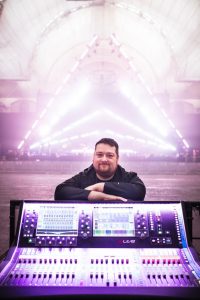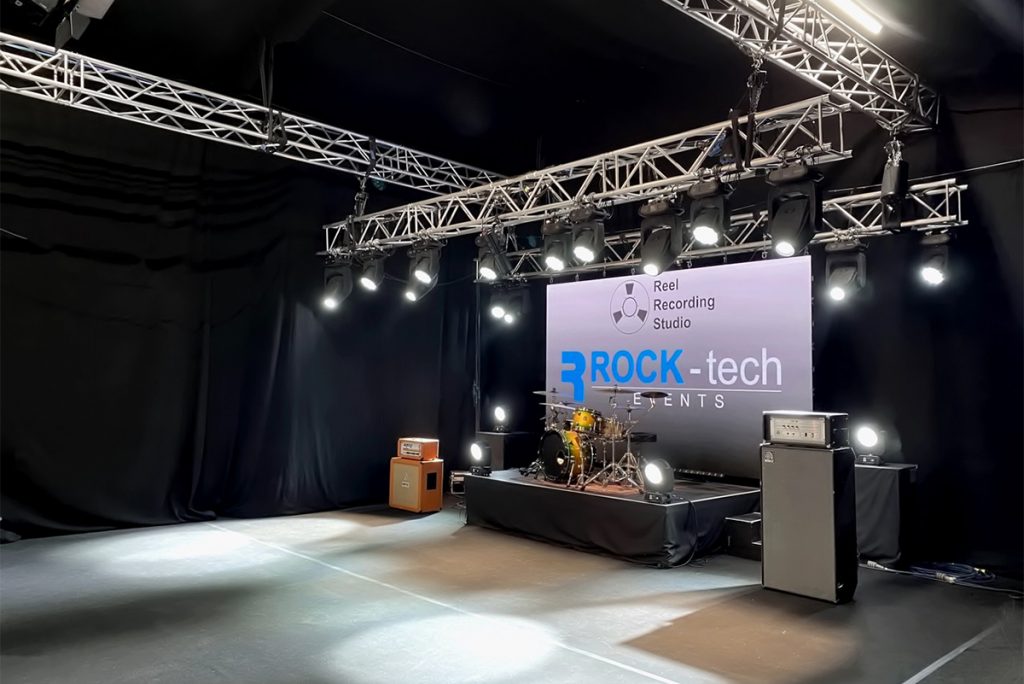The Warehouse – a 10m by 10m studio features adjoining audio and visual control rooms and – was hand-built in association with Reel Recording Studio, offering full socially distant live online event production in a secure setting.
“The COVID-19 pandemic has forced us to diversify and accelerate our progression, creating a bespoke livestreaming studio space to cater for the growing demand for interactive experiences for music fans in lockdown,” Hammond informed TPi, speaking over Zoom. “Everything we’ve built is a permanent fixture, even when live touring returns.”
Located five minutes off the A1, The Warehouse is two hours from most major UK cities. “This enables us to keep our costs down. York is a nice tourist town, which also has its advantages, especially as a lot of up-and-coming performing artists and bands can no longer afford London prices.”
Rock-Tech Events initially invested in the space with a view to creating a recording studio with Dan Mizen of Reel Recording Studio. “As soon as we could become a ‘bubble’, we began building a studio from scratch,” Hammond reflected on the feat of engineering. “We ended up building a completely operational video control room upstairs, a dressing room, bathroom, kitchen, hung a huge lighting rig, video screen and spent a lot of time considering what the perfect space would be for visiting engineers, technicians and performing artists.”
Considering the growing demand for livestreaming spaces, and with a warehouse full of gear gathering dust, the collective decided to transform the 10m by 10m live space into a fully functional, multipurpose livestreaming studio. As a result, the studio can work as a live space for pre-production rehearsals, being used as a control room with a sound engineer.
For livestreams, attendees can take advantage of the studio audio kit – a vintage Rupert Neve console, as well as a separate video control room upstairs, complete with green screen backdrops and photoshoot apparatus. “We wanted to create a space as flexible as possible for the modern musician with every service they could possibly need,” Hammond explained. “We’ve spent our entire lives on tour, or in recording studios, so we understand what our clientele needs and expect when they arrive at The Warehouse.”
Hammond praised his fellow colleagues in getting the project off the ground. “We have a great team of people who can see the bigger picture, and thankfully, we’re all in the same boat. Shout out to Russ Baldwin, who has been my main guy with Rock-Tech and has been amazing throughout this learning process.”

Learning and adapting was indicative of the team’s approach to the task. “We’ve learned a lot,” Hammond stated, having tried his hand as a bricky, electrician, plumber, and roof builder for The Warehouse during the past seven months.
“From a mental health perspective, it’s kept us all sane because it’s given us a purpose and something to strive for. For the touring crew, you mourn the loss of your life because it completely changes with COVID-19. I don’t think many of us have spent this much time at home before.”
Recalling the abundance of touchless hand sanitiser stations, surgical gloves, face masks and antiseptic wipes, Hammond believed that the design of the space also meant that social distancing was comfortable. The audio is tied to one room, as are the SDI lines for the video screens, the PTZ cameras are remotely controlled from the video room. “The Warehouse has been designed to be as safe as possible,” Hammond said. “A band of up to six people can set up, do an eight-camera shoot with not a single person in the room with them if needs be.”
One of the first projects to take place in The Warehouse was a paid-for livestream with pop act, Lawson to promote their latest release in lockdown, as well as a collaboration with Hull-based singer Calum Scott, who performed a live gig on social media, reaching over 50,000 views at the time of writing – raising awareness for Suicide Awareness Week on 10 September, with proceeds donated to the mental health charity, MIND. “We’ve done a lot of work with local bands and it’s been nice to tie in the studio, instead of a crowdfunder to raise money for recording. Artists are able to record their material in the studio, then go next door, do a livestream launch to promote it with online tickets sales, which not only pays for the studio time but generates money for the artists and their label,” Hammond said. “Livestreaming is a viable option for the short term, offering a ticket and premium viewer experience, but I can’t see it happening when live gigs return to the masses.”
From being fully booked all year with the likes of Skunk Anansie, Maisie Peters and Wet Wet Wet, juggling the complexities of being a touring freelancer and business owner, to seeing a year’s worth of work disappear over the course of a week in March was a difficult pill to swallow for Hammond. “I have stuff in the diary for April next year, but who knows if it will go ahead,” he shared. “I’ve had to adapt and diversify to survive. If I can somehow prepare and be ahead of the game, I’ll be ready for when live events return and still be able to pay my mortgage.”
Embodying the “buckle down to survive” mantra, Hammond looked to the uncertain future as a small, bespoke company with a small and faithful client base. He concluded: “I’m engaging in conversations with a number of production managers about using The Warehouse as a production space, taking tentative bookings for next year, while still offering a full in-house service package.”
This article originally appeared in issue #255 of TPi, which you can read here.


